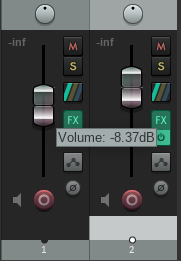World Decibel How-To
A decibel is “a unit of ratio”. In fact, it’s ‘unitless’, insofar as it’s a ratio of two values with units.
The ratio of a 60-pound dog’s weight to a 6-pound dog’s weight is the unitless value “10”, as in “that dog is 10 times the weight of this dog”. It’s like that.
Specifically, the decibel is really good at representing “pretty big” or “pretty small” ratios.
Basics
Remember scientific notation? You’d write 20000 as 2×104? Decibels are that sort of “zeroes compression” as a unit: we write “43dB” instead.
Specifically, they’re logarithmic, meaning we add to the numeric value of the decibel when we multiply the ratio by any value. The decibel is calibrated to the 10th root of 10, which is a fancy and terrible way of saying that, when you multiply the value of a ratio by 10, you add 10 dB.
That applies for all powers of ten! If we multiply by 100, we add 20dB. If we divide by 10, we subtract 10dB. If we multiply by 1…. well, we get zero dB. “Unity,” as some call it.
Intuitively, decibels are written as 10dB times the scientific notation exponent, plus a quantity less than 10dB representing the value in front. Generally, a×10b lands between 10a and 10(a+1) dB–– so if you see something to the order of 65dB, you know immediately it means a ratio between 1 and 10 million. Quick expansion!
What’s the extra value in front? Well, it’s exactly 10×log10(a) dB; in practice this isn’t something you know by hand, other than knowing that 3dB means a ratio of about 2. Decibels are about orders of magnitude, usually.
Note that a ratio of 1:1 is zero dB, not 1 dB! 1dB is about a ratio of 1.259:1.
Why?
Decibels adding means you can combine ratios very easily! If you have measurement B that’s 374 times the size of measurement A, and measurement C that’s 28.4 times the size of measurement B, comparing the ratio of A and C directly needs you to get out the longhand arithmetic or the pocket calculator.
By contrast, if you know measurement B is 10 log10(374) = 25.7 dB more than measurement A, and measurement C is 14.5 dB more than B, you can do quick mental math to find out that measurement C is 25.7 + 14.5 ≈ 40dB greater than measurement A, or about 10 thousand times measurement A. How convenient!!
Sound?
So the most classic way to use decibels is measuring sound. Sound is perceptually exponential, which means that doubling the “absolute volume” (“sound power level”, SPL) will increase how loud you hear it as by a certain amount; doubling it again will increase it by that same amount, even though your sound is now four times the original’s volume in terms of absolute measurements. Wild!
This means that taking the log of this exponential function produces a roughly linear curve— so a linear increase in decibel value means an exponential increase in absolute volume, which means a linear increase in sound! In other words: bump up the decibels value, sound gets louder just-so. Nice!
But remember, the decibel is a ratio: it is the ratio of two values, so it’s unitless, rather than being an absolute value. Generally, measured sound levels are quoted implicitly as a ratio against a reference value; this reference value, 0dB, is defined to be the quietest sound humans can hear: about 10-12 watts in terms of pressure power.
What about digital audio?
So here’s a screencap from Reaper:

Negative decibel values? What gives?
Notably, the decibel value is negative! Do we have to retool our entire understanding of decibels?
Nah. Decibels are relative, remember? Digital audio tools just, by convention, chooses a different reference point. Since the “encoded” version can be played through a speaker at a wide range of different “real” volumes, we can’t pick a cutoff to be the “smallest”; instead, we choose 0dB to be the largest possible volume. In floating point, this is -1.0 to 1.0; in fixed-point, this is defined to be the highest you can go before clipping.
To convert from digital audio decibels to playback audio decibels, add the digital audio dB (which will be negative, to represent a ratio less than 1) to the maximum dB volume of the speaker you’re playing it on.